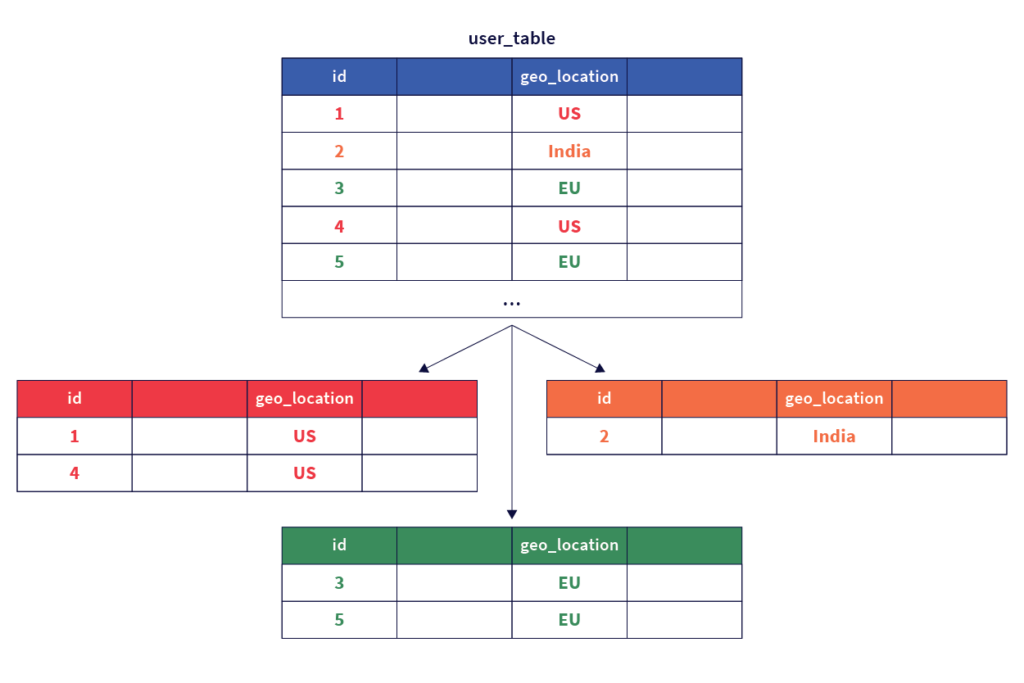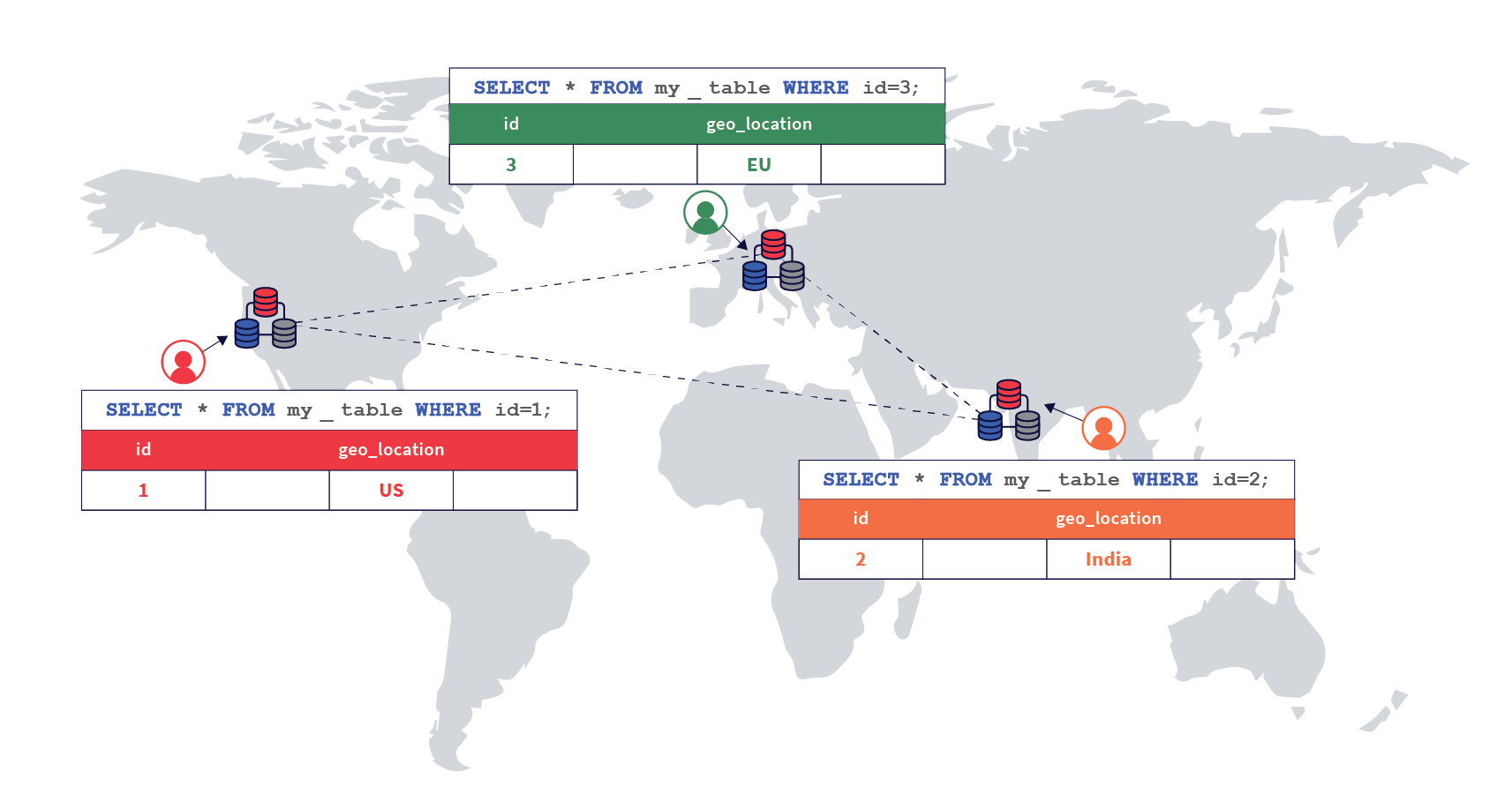Geo-Partitioning of Data in YugabyteDB
Achieve high performance and regulatory compliance for global apps

We are excited to announce the availability of row-level geo-partitioning in YugabyteDB, a feature heavily requested by our user community and enterprise customers alike. This feature allows fine-grained control over pinning data in a user table (at a per-row level) to geographic locations, thereby allowing the data residency to be managed at the database level.
Making the nodes of a multi-region database cluster aware of the location characteristics of the data they store allows conforming to regulatory compliance requirements such as GDPR by keeping the appropriate subset of data local to different regions, and is arguably the most intuitive way to eliminate the high latency that would otherwise get incurred when performing operations on faraway, remote regions.
In keeping with our 100% open source ethos, this feature is available in YugabyteDB under the Apache 2.0 license, so you can try it out right from your laptop! This blog post will dive into the details of this feature such as the high-level design, use-case benefits, as well as how to use it.
Why geo-partition data?
Geo-partitioning of data is critical to some global applications. However, global applications are not deployed using one particular multi-region deployment topology. The multi-region deployment topologies could vary significantly depending on the needs of the application, some of which are very common and critical.
In order to understand why geo-partitioning is useful, it is necessary to understand some of these deployment topologies, which are summarized in the table below.
| Synchronous multi-region | Asynchronous multi-region | Geo-partitioned multi-region | |
|---|---|---|---|
| Data replication across geographies | All data replicated across regions | All data replicated inside region, some data replicated across regions | Data partitioned across regions, partitions replicated inside region |
| Latency of queries from different regions | High | Low | Low |
| Consistency semantics | Transactional | Eventual consistency | Transactional |
| Schema changes across regions | Transparently managed | Manually propagated | Transparently managed |
| Data loss on region failure | None | Some data loss (data loss is dependent on replication timing) | No data loss (partial unavailability is possible) |
Note: Geographic location of data is just one factor that can impact latency and shouldn’t be used in isolation to lower latency. Other factors should be taken into account while evaluating latency, including but not limited to network topology.
As seen from the table above, geo-partitioning can satisfy use cases that need low latencies without sacrificing transactional consistency semantics and transparently perform schema changes across the regions. Geo-partitioning makes it easy for developers to move data closer to users for lower latency, with higher performance, and to meet regulatory data residency requirements.
How does it work?
Geo-partitioning of data enables fine-grained, row-level control over the placement of table data across different geographical locations. This is accomplished in two simple steps – first, partitioning a table into user-defined table partitions, and subsequently pinning these partitions to the desired geographic locations by configuring metadata for each partition.
The first step of creating user-defined table partitions is done by designating a column of the table as the partition column that will be used to geo-partition the data. The value of this column for a given row is used to determine the table partition that the row belongs to. The figure below shows this.

The second step involves configuring the partitions created in step one to pin data to the respective geographic locations by setting the appropriate metadata. Note that the data in each partition can be configured to get replicated across multiple zones in a cloud provider region, or across multiple nearby regions / datacenters.

An entirely new geographic partition can be introduced dynamically by adding a new table partition and configuring it to keep the data resident in the desired geographic location. Data in one or more of the existing geographic locations can be purged efficiently simply by dropping the necessary partitions. Users of traditional RDBMS would recognize this scheme as being close to user-defined list-based table partitions, with the ability to control the geographic location of each partition.
In this deployment, users can access their data with low latencies because the data resides on servers that are geographically close by, and the queries do not need to access data in far away geographic locations. This is shown in the diagram below.

Example scenario
Let us look at this feature in the context of a use case. Say that a large but imaginary bank, Yuga Bank, wants to offer an online banking service to users in many countries by processing their deposits, withdrawals, and transfers. The following attributes would be required in order to build such a service.
- Transactional semantics with high availability: Consistency of data is paramount in a banking application, hence the database should be ACID compliant. Additionally, users expect the service to always be available, making high availability and resilience to failures a critical requirement.
- High performance: The online transactions need to be processed with a low latency in order to ensure a good end-user experience. This requires that the data for a particular user is located in a nearby geographic region. Putting all the data in a single location in an RDBMS would mean the requests for users residing far away from that location would likely have very high latencies, leading to a poor user experience.
- Data residency requirements for compliance: Many countries have regulations around which geographic regions the personal data of their residents can be stored in, and bank transactions being personal data are subject to these requirements. For example, India has a requirement issued by the Reserve Bank of India (or RBI for short) making it mandatory for all banks, intermediaries, and other third parties to store all information pertaining to payments data in India – though in case of international transactions, the data on the foreign leg of the transaction can be stored in foreign locations.
Pitfalls of the traditional “one database per region” approach
It is possible to deploy and manage independent relational databases in the different geographic regions, each storing the data for the appropriate set of users to achieve both data locality and compliance with regulatory requirements. The disadvantages of such an approach are:
- Since a given user can travel and perform transactions from different geographic regions, the data for that user can get fragmented over different independent databases over time. Operations such as viewing the transaction history for a user can get hard to implement.
- Additionally, the application would need to encode the database deployment topology in order to connect to the correct set of databases for a given user, and would need to be constantly updated as the deployment topology changes. This can make the application development very complex.
- Ensuring high availability and scalability of multiple single-node RDBMS in production databases is operationally very hard and error prone.
Using geo-partitioning for the example scenario
In the geo-partitioning approach, we simply deploy one YugabyteDB cluster across the different regions and create a geo-partitioned table for storing the user transactions as shown below.
Step 1. Create the parent table
First, we create the parent table that contains a geo_partition column which is used to create list-based partitions for each geographic region we want to partition data into.
CREATE TABLE transactions (
user_id INTEGER NOT NULL,
account_id INTEGER NOT NULL,
geo_partition VARCHAR,
account_type VARCHAR NOT NULL,
amount NUMERIC NOT NULL,
txn_type VARCHAR NOT NULL,
created_at TIMESTAMP DEFAULT NOW()
) PARTITION BY LIST (geo_partition);
Later, we will create a partition per desired geography under the parent table. To do this, we will first create tablespaces that correspond to the geographical regions that we want to place data in.
Next, we create one partition per desired geography under the parent table. In the example below, we create three table partitions – one for the EU region called transactions_eu, another for the India region called transactions_india, and a third default partition for the rest of the regions called transactions_default.
CREATE TABLE transactions_eu
PARTITION OF transactions
(user_id, account_id, geo_partition, account_type,
amount, txn_type, created_at,
PRIMARY KEY (user_id HASH, account_id, geo_partition))
FOR VALUES IN ('EU');
CREATE TABLE transactions_india
PARTITION OF transactions
(user_id, account_id, geo_partition, account_type,
amount, txn_type, created_at,
PRIMARY KEY (user_id HASH, account_id, geo_partition))
FOR VALUES IN ('India');
CREATE TABLE transactions_default
PARTITION OF transactions
(user_id, account_id, geo_partition, account_type,
amount, txn_type, created_at,
PRIMARY KEY (user_id HASH, account_id, geo_partition))
DEFAULT;
Note that these statements above will create the partitions, but will not pin them to the desired geographical locations. This is done in the next step. The table and partitions created so far can be viewed using the \d command.
yugabyte=# \d
List of relations
Schema | Name | Type | Owner
--------+----------------------+-------+----------
public | transactions | table | yugabyte
public | transactions_default | table | yugabyte
public | transactions_eu | table | yugabyte
public | transactions_india | table | yugabyte
(4 rows)
Step 2. Create Tablespaces for each region
We want to create partitions in 3 regions – EU, India and US. To do this, we will create 3 tablespaces, each corresponding to the regions mentioned above.
For our example, we are going to use regions and zones in the AWS cloud.
CREATE TABLESPACE eu_central_1_tablespace WITH (
replica_placement='{"num_replicas": 3, "placement_blocks":
[{"cloud":"aws","region":"eu-central-1","zone":"eu-central-1a","min_num_replicas":1},
{"cloud":"aws","region":"eu-central-1","zone":"eu-central-1b","min_num_replicas":1},
{"cloud":"aws","region":"eu-central-1","zone":"eu-central-1c","min_num_replicas":1}]}'
);
CREATE TABLESPACE us_west_2_tablespace WITH (
replica_placement='{"num_replicas": 3, "placement_blocks":
[{"cloud":"aws","region":"us-west-2","zone":"us-west-2a","min_num_replicas":1},
{"cloud":"aws","region":"us-west-2","zone":"us-west-2b","min_num_replicas":1},
{"cloud":"aws","region":"us-west-2","zone":"us-west-2c","min_num_replicas":1}]}'
);
CREATE TABLESPACE ap_south_1_tablespace WITH (
replica_placement='{"num_replicas": 3, "placement_blocks":
[{"cloud":"aws","region":"ap-south-1","zone":"ap-south-1a","min_num_replicas":1},
{"cloud":"aws","region":"ap-south-1","zone":"ap-south-1b","min_num_replicas":1},
{"cloud":"aws","region":"ap-south-1","zone":"ap-south-1c","min_num_replicas":1}]}'
);Step 3. Create partitions of the parent table in each region
Now that we have our parent table and the required tablespaces, we will now create partitions for the table corresponding to each geographical region. In the example below, we create three table partitions – one for the EU region called transactions_eu, another for the India region called transactions_india, and a third partition for regions called transactions_us.
CREATE TABLE transactions_eu
PARTITION OF transactions
(user_id, account_id, geo_partition, account_type,
amount, txn_type, created_at,
PRIMARY KEY (user_id HASH, account_id, geo_partition))
FOR VALUES IN ('EU') TABLESPACE eu_central_1_tablespace;;
CREATE TABLE transactions_india
PARTITION OF transactions
(user_id, account_id, geo_partition, account_type,
amount, txn_type, created_at,
PRIMARY KEY (user_id HASH, account_id, geo_partition))
FOR VALUES IN ('India') TABLESPACE ap_south_1_tablespace;
CREATE TABLE transactions_us
PARTITION OF transactions
(user_id, account_id, geo_partition, account_type,
amount, txn_type, created_at,
PRIMARY KEY (user_id HASH, account_id, geo_partition))
FOR VALUES IN ('US') TABLESPACE us_west_2_tablespace;The table and partitions created so far can be viewed using the \d command.
yugabyte=# \d List of relations Schema | Name | Type | Owner --------+----------------------+-------+---------- public | transactions | table | yugabyte public | transactions_eu | table | yugabyte public | transactions_india | table | yugabyte public | transactions_us | table | yugabyte (4 rows)
Step 4. Pinning user transactions to geographic locations
Now, the setup should automatically be able to pin rows to the appropriate regions based on the value set in the geo_partition column. Let us test this by inserting a few rows of data and verifying they are written to the correct partitions.
First, we insert a row into the table with the geo_partition column value set to EU below.
INSERT INTO transactions
VALUES (100, 10001, 'EU', 'checking', 120.50, 'debit');
The row above should be inserted into the transactions_eu partition, and not in any of the others. We can verify this as shown below. Note that we have turned on the expanded auto mode output formatting for better readability by running the statement shown below.
yugabyte=# \x auto Expanded display is used automatically.
The row must be present in the transactions table, as seen below.
yugabyte=# select * from transactions; -[ RECORD 1 ]-+--------------------------- user_id | 100 account_id | 10001 geo_partition | EU account_type | checking amount | 120.5 txn_type | debit created_at | 2020-11-07 21:28:11.056236
Additionally, the row must be present only in the transactions_eu partition, which can be easily verified by running the select statement directly against that partition. The other partitions should contain no rows.
yugabyte=# select * from transactions_eu;
-[ RECORD 1 ]-+---------------------------
user_id | 100
account_id | 10001
geo_partition | EU
account_type | checking
amount | 120.5
txn_type | debit
created_at | 2020-11-07 21:28:11.056236
yugabyte=# select count(*) from transactions_india;
count
-------
0
yugabyte=# select count(*) from transactions_us;
count
-------
0
Now, let us insert data into the other partitions.
INSERT INTO transactions
VALUES (200, 20001, 'India', 'savings', 1000, 'credit');
INSERT INTO transactions
VALUES (300, 30001, 'US', 'checking', 105.25, 'debit');
These can be verified as shown below.
yugabyte=# select * from transactions_india; -[ RECORD 1 ]-+--------------------------- user_id | 200 account_id | 20001 geo_partition | India account_type | savings amount | 1000 txn_type | credit created_at | 2020-11-07 21:45:26.011636 yugabyte=# select * from transactions_us; -[ RECORD 1 ]-+--------------------------- user_id | 300 account_id | 30001 geo_partition | US account_type | checking amount | 105.25 txn_type | debit created_at | 2020-11-07 21:45:26.067444
Step 5. Users traveling across geographic locations
In order to make things interesting, let us say user 100, whose first transaction was performed in the EU region travels to India and the US, and performs two other transactions. This can be simulated by using the following statements.
INSERT INTO transactions
VALUES (100, 10001, 'India', 'savings', 2000, 'credit');
INSERT INTO transactions
VALUES (100, 10001, 'US', 'checking', 105, 'debit');
Now, each of the transactions would be pinned to the appropriate geographic locations. This can be verified as follows.
yugabyte=# select * from transactions_india where user_id=100; -[ RECORD 1 ]-+--------------------------- user_id | 100 account_id | 10001 geo_partition | India account_type | savings amount | 2000 txn_type | credit created_at | 2020-11-07 21:56:26.760253 yugabyte=# select * from transactions_us where user_id=100; -[ RECORD 1 ]-+--------------------------- user_id | 100 account_id | 10001 geo_partition | US account_type | checking amount | 105 txn_type | debit created_at | 2020-11-07 21:56:26.794173
All the transactions made by the user can efficiently be retrieved using the following SQL statement.
yugabyte=# select * from transactions where user_id=100 order by created_at desc; -[ RECORD 1 ]-+--------------------------- user_id | 100 account_id | 10001 geo_partition | US account_type | checking amount | 105 txn_type | debit created_at | 2020-11-07 21:56:26.794173 -[ RECORD 2 ]-+--------------------------- user_id | 100 account_id | 10001 geo_partition | India account_type | savings amount | 2000 txn_type | credit created_at | 2020-11-07 21:56:26.760253 -[ RECORD 3 ]-+--------------------------- user_id | 100 account_id | 10001 geo_partition | EU account_type | checking amount | 120.5 txn_type | debit created_at | 2020-11-07 21:28:11.056236
Step 6. Adding a new geographic location
Assume that after a while, our fictitious Yuga Bank gets a lot of customers across the globe, and wants to offer the service to residents of Brazil, which also has data residency laws. Thanks to row-level geo-partitioning, this can be accomplished easily. We can simply add a new partition and pin it to the AWS South America (São Paulo) region sa-east-1 as shown below.
CREATE TABLESPACE sa_east_1_tablespace WITH (
replica_placement='{"num_replicas": 3, "placement_blocks":
[{"cloud":"aws","region":"sa-east-1","zone":"sa-east-1a","min_num_replicas":1},
{"cloud":"aws","region":"sa-east-1","zone":"sa-east-1b","min_num_replicas":1},
{"cloud":"aws","region":"sa-east-1","zone":"sa-east-1c","min_num_replicas":1}]}'
);
CREATE TABLE transactions_brazil
PARTITION OF transactions
(user_id, account_id, geo_partition, account_type,
amount, txn_type, created_at,
PRIMARY KEY (user_id HASH, account_id, geo_partition))
FOR VALUES IN ('Brazil') TABLESPACE sa_east_1_tablespace;
And with that, the new region is ready to store transactions of the residents of Brazil.
INSERT INTO transactions
VALUES (400, 40001, 'Brazil', 'savings', 1000, 'credit');
yugabyte=# select * from transactions_brazil;
-[ RECORD 1 ]-+-------------------------
user_id | 400
account_id | 40001
geo_partition | Brazil
account_type | savings
amount | 1000
txn_type | credit
created_at | 2020-11-07 22:09:04.8537
Conclusion
YugabyteDB thus offers row-level geo-partitioning capabilities in addition to follower reads, synchronous replication across 2 or more regions and asynchronous replication across 2 or more regions (called xCluster replication. These extensive multi-region features makes YugabyteDB the distributed SQL database with the most comprehensive set of multi-region deployment options. These deployment options across multiple data centers, regions and/or clouds give users even more control to bring data close to their customers for performance, costs, or compliance reasons. All of the features mentioned are 100% open source under the Apache v2 license.
If you have any questions, please join our community Slack channel. Interested in working on these types of cutting-edge features? We’re hiring!
Note: This blog post was edited on 07/28/2021. Specifically, the steps using yb-admin command line tool to pin partition tables to geographic regions, have been replaced with the newly introduced YSQL Tablespaces syntax to specify placement configuration for tables.


